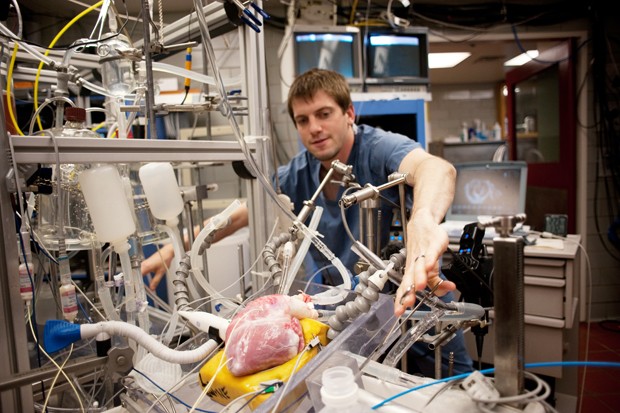In a lab in the basement of a University of Minnesota building, researchers have performed heart transplants with humans, swine, canines and guinea pigs acting as donors. But the recipient of the different transplant hearts always stays the same. The Visible Heart Laboratory transplants a heart and maintains its physiological processes by placing it into an apparatus that allows for truly unique research for scientists and premier bench testing for the labâÄôs collaborator, Medtronic, a medical technology company based in Minneapolis. Paul Iaizzo, associate director of the Institute for Engineering in Medicine, said male swine otherwise going to the slaughterhouse provide the majority of the hearts used for research. However, the lab has also had the opportunity to work with about 40 human hearts deemed unfit for the donor list. Once the heart is acquired, it is cut out of the donor in a room adjacent to the apparatus, according to Iaizzo, who said he is the only person to perform the procedure for the 700-800 hearts the lab has seen since it began work in 1997. Iaizzo, who is the principal investigator of the lab, said he then places the heart into the apparatus, which is another process he has performed exclusively since the lab started. Placing the heart into the apparatus to mimic the correct physiology is a procedure many scientists have not been able to replicate because of the delicate nature of the process, according to Iaizzo. âÄúWe place magic dust, and we wave a magic wand,âÄù Iaizzo said jokingly. Once correctly placed in the apparatus, Iaizzo said the heart is observed using a wide variety of monitoring devices, worth a total of about $1 million. âÄúWe are always getting technologies to both use and monitor the heart,âÄù Iaizzo said. âÄúWe are really doing cutting-edge stuff.âÄù Steve Howard, a second-year doctoral student in biomedical engineering, said the lab features the same equipment used in surgical rooms in which heart transplants are performed. âÄúIt really gives you the full gamut of how the heart is functioning,âÄù Howard said. The collaboration with Medtronic allows the company to use this equipment and the hearts donated to the lab. However, the medical device company does not have precedence when it comes to use of the four- to five-hour lifespan of the heart on the apparatus, according to Iaizzo. The first two hours are reserved for collecting images for educational purposes, according to Iaizzo, who said the capabilities of the lab produce images that were once impossible. Iaizzo said the different anatomy that is now visible by cameras placed inside the heart quickly caught the attention of clinicians. âÄúThey would come up to us and let us know how incredible these images are,âÄù Iaizzo said. âÄúWe knew we had a lot of new value.âÄù With these images, the lab has also started the Atlas of Human Cardiac Anatomy, which is a free database of the unique images of the heart. âÄúIt is all philanthropic,âÄù Iaizzo said. âÄúThe goal is to go out and share these images.âÄù Also using the advanced imaging are doctoral students, who gain access to the heart apparatus after the educational needs are met. Iaizzo said the majority of doctoral students do the research project for their thesis in the lab. For example, Chris Rolfes, a third-year doctoral student in biomedical engineering, said he is working on using fatty acids to treat the heart prior to transplant to give it more strength throughout the heart transplant process. Rolfes said the environment is perfect for his research. âÄúThe ability to mimic a heart transplant using the apparatus provides the value for my research,âÄù Rolfes said. Also, Howard said he is currently looking at different chemical agents that would help the heart recover from some of the damage incurred during a heart attack. Howard said the value of the lab for his project is the multiple disciplines they are able to use in approaching questions with mechanical engineers, biologists, physicists and others all present. âÄúWe are able to pull together and look at the problems from all different sides of the equation,âÄù Howard said. Finally gaining access to the heart apparatus is Medtronic, which uses the apparatus to test medical devices that are either prototypes or already on the market. Dr. Alex Hill, principal scientist in cardiovascular research at Medtronic, said the lab provides the most realistic testing platform outside of a living human being. âÄúThe physiological process cannot be perfectly mimicked, but as a bench test, it is as close as we can get,âÄù Hill said. Hill said Medtronic uses swine hearts to test some of their early prototypes of medical devices, but some projects are set aside until a human heart becomes available at the lab. Once the lab receives the heart, Hill said Medtronic is paged by someone at the lab, which can happen at any point in the day or night. âÄúWe have [devices] already ready to go,âÄù Hill said. âÄúYou really have to be ready at any moment,âÄù Hill said. Back at the University, Rolfes said the group at the lab also has pagers that will alert the staff when a human heart becomes available. Depending on where the heart is, Rolfes said they have four to eight hours to get the heart to the lab. Although the call sometimes comes at 4 a.m., Rolfes said there is always a sense of excitement. âÄúIf we need to get up and get stuff ready, we will get stuff ready,âÄù Rolfes said.

Image by Jules Ameel
Bio Medical PHD student Chris Rolfes works on an experiment Tuesday in the Visible Heart Laboratory in the Mayo Building.
U researchers get inside look at heart
700-800 hearts have been transplanted at the Visible Heart Laboratory.
Published April 29, 2010
1

